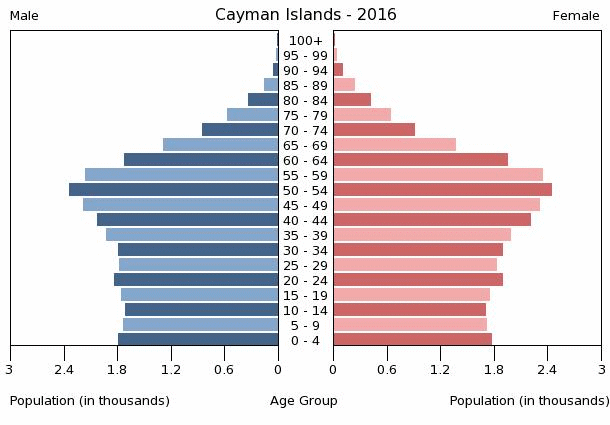Cayman Islands - People
 Data from the 1999 census year and from preliminary results from the 2010 census showed that the resident population, including both Caymanians and non-Caymanians, increased from 39,410 to 54,397. This reflected an overall 38.0% rise between the censuses, for an average annual growth rate at 3.0%.
Data from the 1999 census year and from preliminary results from the 2010 census showed that the resident population, including both Caymanians and non-Caymanians, increased from 39,410 to 54,397. This reflected an overall 38.0% rise between the censuses, for an average annual growth rate at 3.0%.
The sharp increase in the population began in 2005, following Hurricane Ivan, when residents returned to the island and there was an increase in the labor force needed to reconstruct the territory. In 2010, 95.7% of the population resided on Grand Cayman, with 50.9% in just the capital city. The two sister islands accounted for the remaining 4.3% of the total resident population.
Caymanians have a tradition of hardiness and independence of spirit, which sustained them through many difficult years when their home was sometimes referred to as "the islands time forgot." In those years, they earned a livelihood at sea, either as turtle fishermen or as crew members on foreign-owned ships, or by working in North and Central America.
In 1906 more than a fifth of the population of 5,000 was estimated to be at sea, and even as late as the 1950s the government annual report said that the main "export" was seamen who sent money home to their families. Tourism was still undeveloped at this time. Even in 1970 the population of the Cayman Islands was 10,249, with only 403 recorded visitors.
Caymanians are renowned for their friendliness and are devout, church-going people. They are proud of their multiracial and multicultural origins. Approximately one in four is European, mainly descended from British settlers. A further quarter is of African descent, and the rest claim mixed ancestry.
Most of the population of 57,268 (July 2016 est.) lives on Grand Cayman. Ethnic groups include mixed 40%, white 20%, black 20%, expatriates of various ethnic groups 20%.
The most popular religion by one estiamte was Church of God (25.5%), followed by Roman Catholic (12.6%). By another estimate, religions included Protestant 67.8% (includes Church of God 22.6%, Seventh Day Adventist 9.4%, Presbyterian/United Church 8.6%, Baptist 8.3%, Pentecostal 7.1%, non-denominational 5.3%, Anglican 4.1%, Wesleyan Holiness 2.4%), Roman Catholic 14.1%, Jehovah's Witness 1.1%, other 7%, none 9.3%, unspecified 0.7% (2010 est.)
Based on the 1999 census, the largest proportion of the population (12.5%) was in the 3034-year age group, followed by the age groups 2029 years old and 3539 years old (both 11.4%). Those 60 years old and older accounted for 8.3%. The dependency ratio was 33.8%.
In 2009, the population was estimated at 55,672. The 2009 age distribution of the population mirrored that seen in 1999. In 2009, Caymanians represented 58.9% of the population, and nonCaymanians 41.0%.
The school system is patterned after the British educational system. Presently the government runs a special education school, 10 primary schools, two high schools, a university and a school of law. Education is free to Caymanians.
In 2007, the total adult literacy rate was 98.9% (males 98.7% and females 99.0%). In 2006, the birth rate was 13.7 per 1,000 population (710 births). This increased to a rate of 14.9/1,000 (821 births) in 2010. The number of registered deaths decreased from l82 (3.5/1,000 mid-year population) in 2006 to 152 (2.8/1,000) in 2010. Births and deaths of residents that occurred outside the territory are not included in these figures. For the 20092010 period, live births were 48.4% female and 51.4% male.
With an estimated 1.9% of the population (989 persons) falling below the poverty line, the Cayman Islands had the lowest rate of estimated poverty in the Commonwealth Caribbean since 1999. However, in terms of inequality, the Cayman Islands had a Gini coefficient of 0.4, which was higher than that for several other Caribbean countries.
Given that its per capita GDP approximates that of a developed country, the high Gini ratio suggests that the territory experiences a higher level of inequality than is to be expected at its level of development. While only 1.9% of individuals were deemed to be poor, a review of conditions of the poorest 20% does provide additional insights into some of the difficulties Caymanians face. For example, conditions for women in the lowest quintile were worse than those for male-headed households. Female-headed households accounted for almost half of poor households, which was more than their presence in the overall number of households. It is noteworthy that, among the poor and the vulnerable, a large number had no children.

|
NEWSLETTER
|
| Join the GlobalSecurity.org mailing list |
|
|
|

